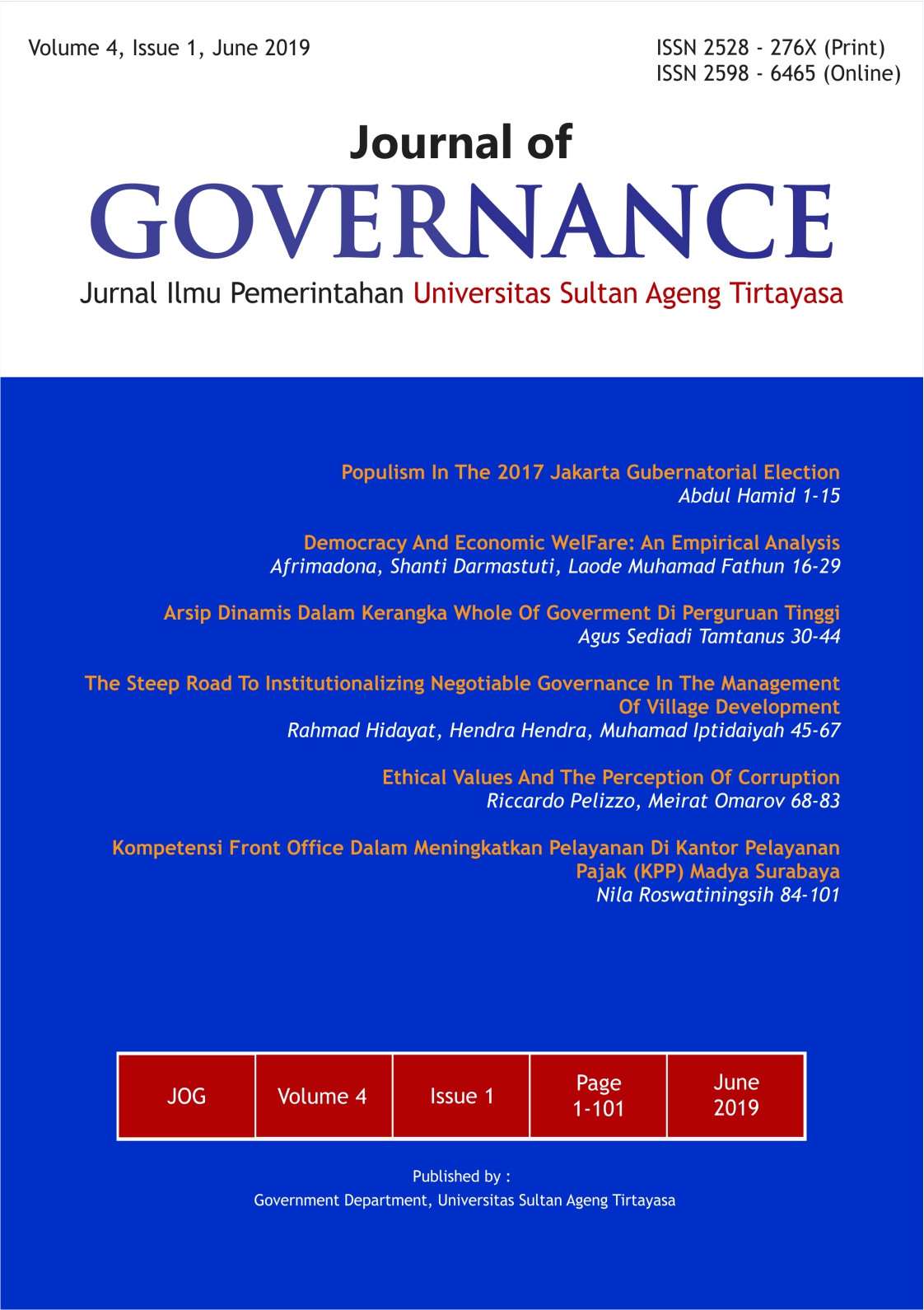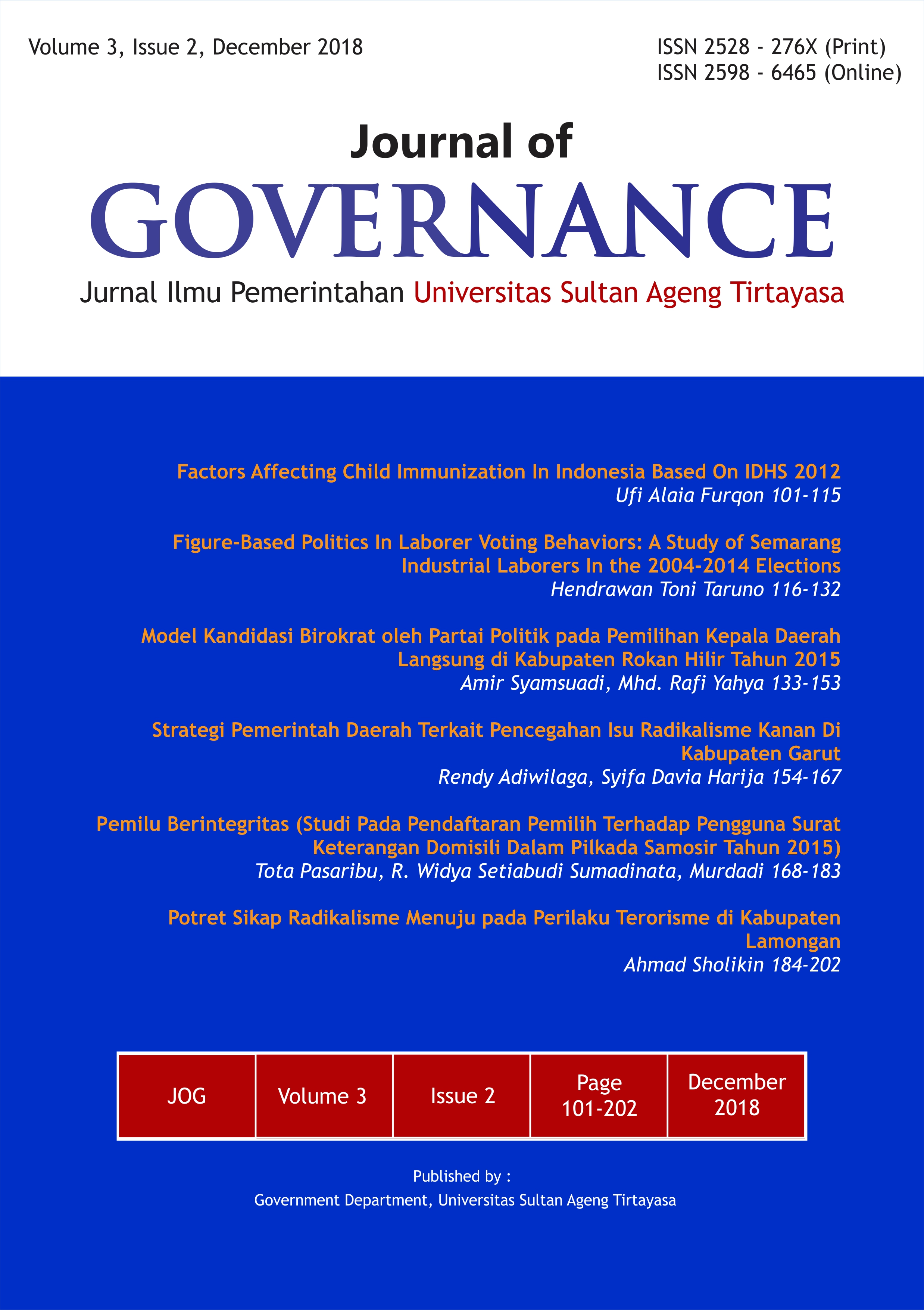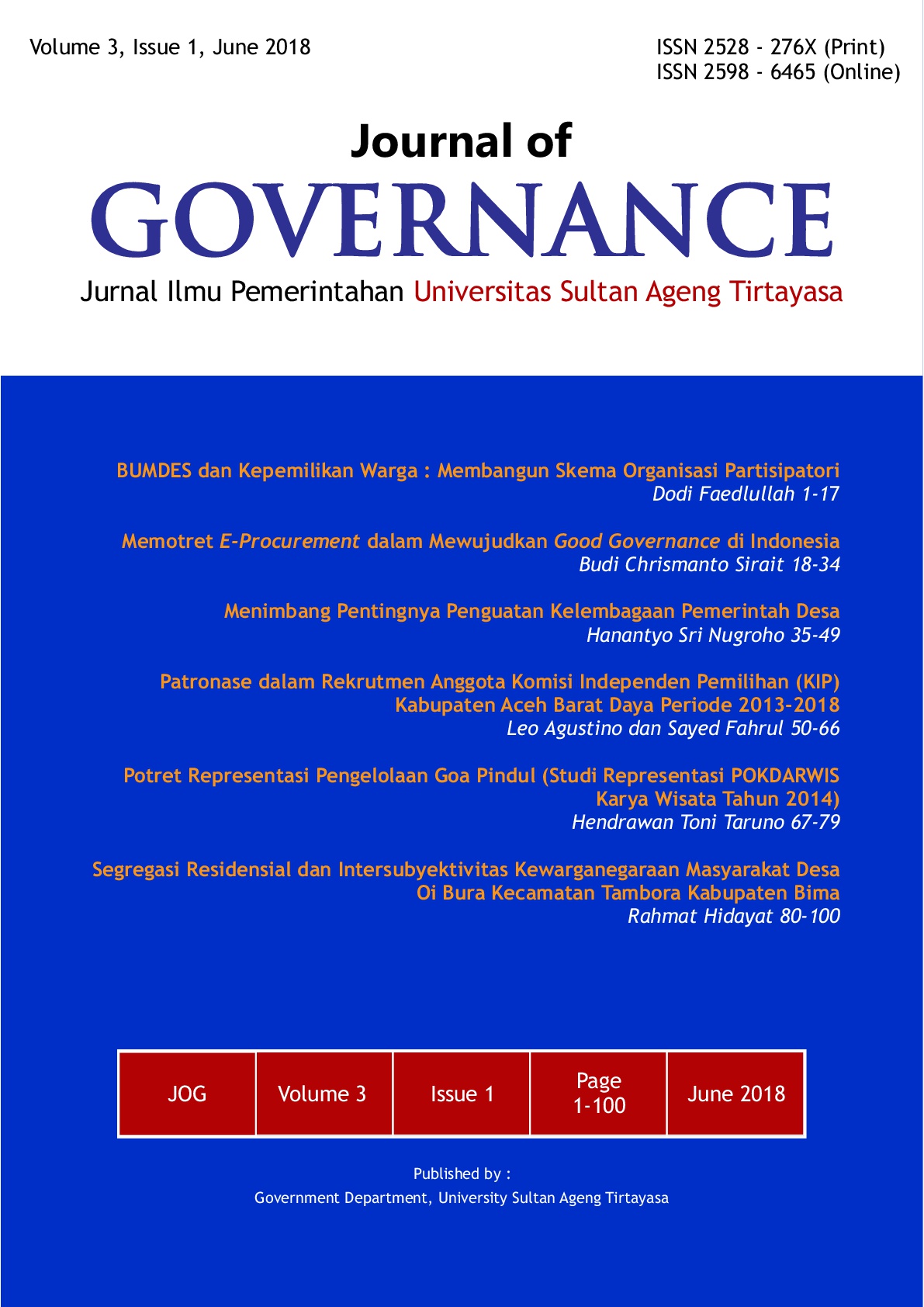Analysis of Formulation of National Development Risk Management Policy Using Regulatory Impact Analysis Method
Abstract
The existence of several government program failures that occurred finally forced the government to issue Presidential Regulation Number 39 of 2023 concerning National Development Risk Management or “Manajemen Risiko Pembangunan Nasional” (MRPN). MRPN is aiming to manage cross-sectoral risks crucial to achieving Indonesia’s 2045 vision. However, the formulation of this policy needs to be analyzed so that its impact on the common good becomes clearer. Regulatory Impact Analysis (RIA) is essential in shaping policies to mitigate overlapping regulations and enhance national development. The research uses a qualitative paradigm that combines document reviews and in-depth interviews with key informants who focus on their roles in policy drafting and risk management. The results, MRPN, are a significant step toward national development risk management, but improvements in policy alternatives, stakeholder engagement, and cost-benefit analyses are required for better outcomes. Enhancing inter-entity coordination to ensure technical guidelines are actionable policies and making a user-friendly technological tool to facilitate communication and data management among stakeholders is also essential to make policy implementation effective.
Keywords
Full Text:
PDF 191-205References
Badan Pengawasan Keuangan dan Pembangunan. (2021). Peraturan Kepala BPKP Nomor 5 Tahun 2021 tentang Penilaian Maturitas Penyelenggaraan Sistem Pengendalian Intern Pemerintah Terintegrasi pada Kementerian/Lembaga/Pemerintah Daerah.
Badan Pengawasan Keuangan dan Pembangunan. (2024). Laporan Kinerja Instansi Pemerintah (LAKIP) Tahun 2023.
Creswell, J. W. (2014). Research design: Qualitative, quantitative, and mixed methods approaches. SAGE Publications. https://www.ucg.ac.me/skladiste/blog_609332/objava105202/fajlovi/Creswell.pdf
Creswell, J. W., & Poth, C. N. (2018). Qualitative inquiry and research design: Choosing among five approaches (4th ed.). SAGE Publications.
Denzin, N. K., & Lincoln, Y. S. (Eds.). (2018). The SAGE handbook of qualitative research (5th ed.). SAGE Publications.
Damayanti, A. (2022, July 12). Sri Mulyani Pusing Pemerintah Punya 24.000 Aplikasi, Bikin Anggaran Boros. https://finance.detik.com/berita-ekonomi-bisnis/d-6174599/sri-mulyani-pusing-pemerintah-punya-24-000-aplikasi-bikin-anggaran-boros
Direktorat Jenderal Peraturan Perundang-undangan. (2024, October 10) https://peraturan.go.id/
Dunne, James Henry, Peter Harris, and Katherine Kinkela. (2023). Case Study: Impact of Regulatory Restrictions and Tax Policy on Breakeven Analysis and Risk Management. Journal of Risk and Financial Management, 16: 179. https://doi.org/10.3390/jrfm16030179
Harrington, W., Heinzerling, L., & Morgenstern, R. D. (2009). Reforming Regulatory Impact Analysis. Resources for the Future.
Hikmah, M. (2020). Penerapan Regulatory Impact Analysis dalam Penerapan BUT di Indonesia di Era Ekonomi Digital. Simposium Keuangan Negara, 699 - 1115.
Ingrams, M. G. (2023). The 2023 Update of the OECD Guidelines sets Stronger Standards for Companies but Weak Expectations for Governments – High and Lowlights from the New Text. Business and Human Rights Journal, 8(3), 427–433. doi:10.1017/bhj.2023.40
Kementerian PPN/Badan Perencanaan Pembangunan Nasional (Bappenas). (2008). Pedoman Penerapan Regulatory Impact Assessment.
Kementerian PPN/Badan Perencanaan Pembangunan Nasional (Bappenas). (2019). Indonesia 2045: Berdaulat, Maju, Adil, dan Makmur.
Kirkpatrick, C., & Parker, D. (2004). Editorial: Regulatory Impact Assessment—An Overview. Public Money & Management, 24(5), 267–270. https://doi.org/10.1111/j.1467-9302.2004.00432.x
Kurniawan, T., Muslim, M. A., & Sakapurnama, E. (2018). Regulatory impact assessment and its challenges: An empirical analysis from Indonesia. Kasetsart Journal of Social Sciences, 39(1), 105-108. https://doi.org/10.1016/j.kjss.2017.12.004
Marušić, A., & Radulović, B. (2011). Regulatory impact analysis (RIA) manual. USAID – Good Governance Activity in Montenegro.
McEntaggart, K., Etienne, J., & de Paolis, S. (2020). The use of emerging technologies for regulation: Main findings and roadmap (BEIS Research Paper Number 2020/041). Department for Business, Energy & Industrial Strategy (BEIS).
Muzari, T., Shava, G. N., & Shonhiwa, S. (2022). Qualitative Research Paradigm, a Key Research Design for Educational The authorss, Processes and Procedures: A Theoretical Overview. Indiana Journal of Humanities and Social Sciences, 3(1), 14-20.
Nurfajriani, W. V., Ilhami, M. W., Mahendra, A., Afgani, M. W., & Sirodj, R. A. (2024). Data Triangulation in Qualitative Data Analysis. Jurnal Ilmiah Wahana Pendidikan, 10(17), 826-833. https://doi.org/10.5281/zenodo.13929272
OECD. (2008). Building an Institutional Framework for Regulatory Impact Analysis (RIA): Guidance for Policy Makers Version 1.1 (Regulatory Policy Division Directorate for Public Governance and Territorial Development). https://web-archive.oecd.org/2012-06-15/123372-40984990.pdf
OECD. (2009). Regulatory impact analysis: A tool for policy coherence. OECD Publishing. https://doi.org/10.1787/9789264067110-en
OECD. (2020). Regulatory impact assessment—OECD best practice principles for regulatory policy. https://www.oecd-ilibrary.org/governance/regulatory-impact-assessment_7a9638cb-en.
Patton, M. Q. (2002). Qualitative research and evaluation methods (3rd ed.). SAGE Publications.
Pin, C. (2023). Semi-structured interviews (LIEPP Methods Brief No. 4). Sciences Po. https://sciencespo.hal.science/hal-04087970v1
Priyarsono, D. S., (2021). Urgensi dan Strategi Implementasi Manajemen Risiko di Sektor Publik. https://irmapa.org/urgensi-dan-strategi-implementasi-manajemen-risiko-di-sektor-publik/ diakses pada 12 Desember 2023
Republik Indonesia. (2008). Peraturan Pemerintah Republik Indonesia Nomor 60 Tahun 2008 tentang Sistem Pengendalian Intern Pemerintah.
Republik Indonesia. (2010). Peraturan Presiden Nomor 81 Tahun 2010 tentang Grand Design Reformasi Birokrasi 2010-2025.
Republik Indonesia. (2014). Peraturan Presiden Republik Indonesia Nomor 192 Tahun 2014 tentang Badan Pengawasan Keuangan dan Pembangunan.
Republik Indonesia. (2023). Peraturan Presiden Nomor 39 Tahun 2023 tentang Manajemen Risiko Pembangunan Nasional.Peraturan Presiden Nomor 192 Tahun 2014 tentang Badan Pengawasan Keuangan dan Pembangunan.
Saab, F., & Midlej e Silva, S. A. (2023). Influence factors on the quality of regulatory impact analysis in Brazil. Impact Assessment and Project Appraisal, 41(6), 476-488. https://doi.org/10.1080/14615517.2023.2268996
Saputra, A. (2019, November 14). Jokowi Keluhkan Banyaknya Regulasi, Kini Ada 43.005 Peraturan di Indonesia. https://news.detik.com/berita/d-4784463/jokowi-keluhkan-banyaknya-regulasi-kini-ada-43-005-peraturan-di-indonesia.
Suska, Suska. 2016. “Prinsip Regulatory Impact Assessment Dalam Proses Penyusunan Peraturan Perundang-Undangan Sesuai UU Nomor 12 Tahun 2011”. Jurnal Konstitusi 9 (2):357-80. https://doi.org/10.31078/jk926.
Srivithaya, S. (2024). Regulatory impact assessment for law reform: A comparison of the parliament role. Corporate Law & Governance Review, 6(1), 69–76. https://doi.org/10.22495/clgrv6i1p7
The Institute of Internal Auditors (IIA). (2020). Model tiga lini: Pembaharuan dari model pertahanan tiga lini. The Institute of Internal Auditors, Inc. https://www.theiia.org/globalassets/documents/resources/the-iias-three-lines-model-an-update-of-the-three-lines-of-defense-july-2020/three-lines-model-updated-indonesian.pdf
UK Government. (2023). The Orange Book: Management of risk – Principles and concepts. Head of the Government Risk Profession, Risk Centre of Excellence. (Originally revised by Mark Ripley in 2020).
Winaryati. (2019). Triangulasi. Action Research Dalam Pendidikan (Antara Teori Dan Praktek), 124–135.
DOI: http://dx.doi.org/10.31506/jog.v10i1.29946
Refbacks
- There are currently no refbacks.
⟨Recent Issues⟩ | ⟨Upcoming Issues⟩ |
Recent Issues
Volume 6, Issue 2: (2021) | Volume 6, Issue 1: (2021) | Volume 5, Issue 2: (2020) | Volume 5, Issue 1: (2020) | Volume 4, Issue 2 (2019) |
 |  |  |  |  |






